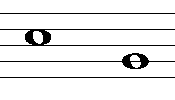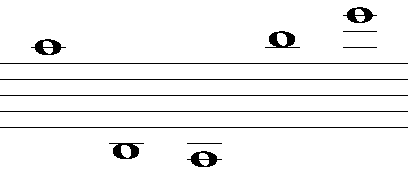- Music is written on a stave (or staff):
- This is five parallel lines drawn horizontally on the page;
- There is normally a bracket of some sort on the left hand end which "holds" the five lines together;
- The stave can be thought of as rungs of a ladder (a rather wide one!): as you go up each step on the rungs, you get higher.

You can click on any note head on this page to hear the note played (see midi comments).
- The pitch of a note is indicated by the position of a circular shaped blop (the head of the note) on the stave:

- it is either in the space between any two lines,
- or straddling one of the lines,
- it has to be in one of these two positions, no other in-between ones are allowed;
- the "head" can look a little different from this and have various attachments, but we'll come to that later.
- Pitch/frequency is approximately proportional to the vertical height of the head of the note on the stave:
- So a high note (high pitch or frequency) is at the top of the stave;
- A low note (low pitch or frequency) is at the bottom of the stave;
- So here is an example of a high note (you can click on the note or here to hear it):

- and here is an example of a low note (click to hear it):

- But the position of notes on a stave like this indicates only relative pitch - all you can say is the the first note is higher than the second.
- There are three aspects where the ladder analogy breaks down:
- As already mentioned, there are two (and only two) positions for a note to sit on each rung;
- There is no "ground level" at the bottom - this is a ladder hung in mid-air!
- In fact, you can easily add extensions at the top or bottom - these are called ledger lines.
- If the note required is too high or too low to fit on the stave, one common way of showing it is by ledger lines:
- A ledger line is an extension, an extra rung, added to the standard five lines, but only for the note it is needed for, and you can add several if necessary.
- Here are some examples (click on the notes to hear them):

- Whenever we talk about pitch, or whether a note is "high" or "low", we actually mean frequency:
- Frequency is the number of beats or vibrations per second;
- A musical note is a regular number of vibrations per second;
- The higher the number of vibrations, the higher the note you hear.
For more details on staves, see Basic Music Theory - stave
For more details on note position, see Basic Music Theory - stave and Basic Music Theory - note pitch
For more details on the physics of frequency and pitch, see Basic Music Theory - frequency or pitch
If you have any questions or comments, please email me






